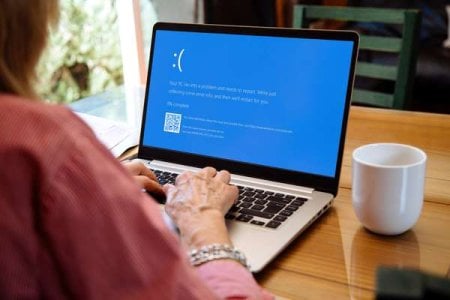Tech trouble: Global outage leaves Aussies in the dark and vulnerable to scams!
- Replies 19
In an age where people’s lives are intricately woven with digital threads, a snag in the fabric can cause a great unravelling.
This is precisely what's happening as a result of a global IT outage that has left millions of Australians vulnerable to a host of cybersecurity threats.
The outage, which has affected an estimated 8.5 million devices worldwide, is not just a temporary inconvenience—it's a dire warning that our safety could be compromised for weeks to come.
The outage was triggered on Friday afternoon, July 19, by a failed update from cybersecurity company CrowdStrike, which inadvertently caused widespread disruptions to Microsoft users.
The ripple effect was immediate and severe, with computer systems crashing across various sectors, including airlines, supermarkets, banks, media outlets, petrol stations, and other major businesses and retailers.
Screens were met with the dreaded ‘blue screen of death’—a colloquial term for a Windows system error that often requires a reboot or other troubleshooting measures.

The timing of the CrowdStrike upgrades, which were carried out overnight in the United States, meant that Australians were hit just before the weekend—traditionally a peak time for travel and shopping.
The fallout was palpable, with airports across the country, including Melbourne's international terminal, experiencing significant delays.
On Sunday, Home Affairs and Cybersecurity Minister Clare O'Neil expressed gratitude to IT staff and other workers for their efforts in getting ‘our economy back up and running’ by working over the weekend.
‘However, it will take time until all affected sectors are completely back online,’ the minister said in a statement.
‘In some cases, we may see teething issues for one or two weeks.’
In the wake of the chaos, Microsoft recommended a rather unorthodox solution: rebooting computers up to 15 times if the device had the blue screen.
While this may seem excessive, it underscores the gravity of the situation and the desperation for a fix.
However, technical issues are only part of the problem. The disruption has created a prime opportunity for scammers to prey on the confusion and urgency of the moment.
Minister O'Neil has issued a stark warning to Australians to be vigilant against potential scammers, reiterating that everyone should be sceptical about messages from anyone offering to fix the problem.
‘Scammers are trying to exploit the outages caused by the CrowdStrike technical incident,’ she cautioned.
‘Be on the lookout for possible scams and phishing attempts.’
People should be cautious of unexpected calls, text messages, and emails that claim to offer assistance.
‘You can help by making sure vulnerable people, including elderly relatives, are being extra cautious at this time,’ the Cybersecurity Minister continued.
A trip to the grocery store or service station might take longer as businesses work to get their systems up and running again. However, Triple-0 and emergency services remain operational.
During the COVID-19 pandemic, a National Coordination Mechanism was established by the Department of Home Affairs to bring together various sectors and ministers to address any crisis.
The group has been convening over the past few days to discuss the outages, including another meeting on Sunday morning.
Ms O'Neil said that CrowdStrike informed the meeting they ‘are now close to rolling out an automatic fix to the issue with their update, as is Microsoft’.
‘This should increase the speed at which systems across the economy are back online,’ they added.
As concerns mount over the recent global outage affecting major tech companies, including CrowdStrike and Microsoft, it's crucial to remain vigilant about potential threats.
With these disruptions, there's an increased risk of encountering misleading or fraudulent online messages. This includes fake error messages that can deceive users into compromising their personal information.
Therefore, it's important for everyone, especially those navigating digital platforms like Google Chrome, to be aware of these scams and take steps to protect themselves.
 Have you or someone you know been affected by the IT outage? Share your experiences and any tips you have for staying secure in the comments below.
Have you or someone you know been affected by the IT outage? Share your experiences and any tips you have for staying secure in the comments below.
This is precisely what's happening as a result of a global IT outage that has left millions of Australians vulnerable to a host of cybersecurity threats.
The outage, which has affected an estimated 8.5 million devices worldwide, is not just a temporary inconvenience—it's a dire warning that our safety could be compromised for weeks to come.
The outage was triggered on Friday afternoon, July 19, by a failed update from cybersecurity company CrowdStrike, which inadvertently caused widespread disruptions to Microsoft users.
The ripple effect was immediate and severe, with computer systems crashing across various sectors, including airlines, supermarkets, banks, media outlets, petrol stations, and other major businesses and retailers.
Screens were met with the dreaded ‘blue screen of death’—a colloquial term for a Windows system error that often requires a reboot or other troubleshooting measures.

A global IT outage caused by a CrowdStrike upgrade has affected 8.5 million devices, potentially affecting Australian services for weeks. Credit: Shutterstock
The timing of the CrowdStrike upgrades, which were carried out overnight in the United States, meant that Australians were hit just before the weekend—traditionally a peak time for travel and shopping.
The fallout was palpable, with airports across the country, including Melbourne's international terminal, experiencing significant delays.
On Sunday, Home Affairs and Cybersecurity Minister Clare O'Neil expressed gratitude to IT staff and other workers for their efforts in getting ‘our economy back up and running’ by working over the weekend.
‘However, it will take time until all affected sectors are completely back online,’ the minister said in a statement.
‘In some cases, we may see teething issues for one or two weeks.’
In the wake of the chaos, Microsoft recommended a rather unorthodox solution: rebooting computers up to 15 times if the device had the blue screen.
While this may seem excessive, it underscores the gravity of the situation and the desperation for a fix.
However, technical issues are only part of the problem. The disruption has created a prime opportunity for scammers to prey on the confusion and urgency of the moment.
Minister O'Neil has issued a stark warning to Australians to be vigilant against potential scammers, reiterating that everyone should be sceptical about messages from anyone offering to fix the problem.
‘Scammers are trying to exploit the outages caused by the CrowdStrike technical incident,’ she cautioned.
‘Be on the lookout for possible scams and phishing attempts.’
People should be cautious of unexpected calls, text messages, and emails that claim to offer assistance.
‘You can help by making sure vulnerable people, including elderly relatives, are being extra cautious at this time,’ the Cybersecurity Minister continued.
A trip to the grocery store or service station might take longer as businesses work to get their systems up and running again. However, Triple-0 and emergency services remain operational.
During the COVID-19 pandemic, a National Coordination Mechanism was established by the Department of Home Affairs to bring together various sectors and ministers to address any crisis.
The group has been convening over the past few days to discuss the outages, including another meeting on Sunday morning.
Ms O'Neil said that CrowdStrike informed the meeting they ‘are now close to rolling out an automatic fix to the issue with their update, as is Microsoft’.
‘This should increase the speed at which systems across the economy are back online,’ they added.
As concerns mount over the recent global outage affecting major tech companies, including CrowdStrike and Microsoft, it's crucial to remain vigilant about potential threats.
With these disruptions, there's an increased risk of encountering misleading or fraudulent online messages. This includes fake error messages that can deceive users into compromising their personal information.
Therefore, it's important for everyone, especially those navigating digital platforms like Google Chrome, to be aware of these scams and take steps to protect themselves.
Key Takeaways
- A global IT outage caused by a CrowdStrike upgrade for Microsoft has affected 8.5 million devices worldwide, potentially impacting Australian services for weeks.
- The Home Affairs and Cybersecurity Minister, Clare O'Neil, advised Australians to be cautious of scammers taking advantage of the situation.
- The IT crash affected systems at airports, supermarkets, banks, media outlets, petrol stations, and other businesses, causing widespread disruptions.
- The government is mobilising resources to address the outage, with CrowdStrike and Microsoft working on automatic fixes to resolve the issues.







